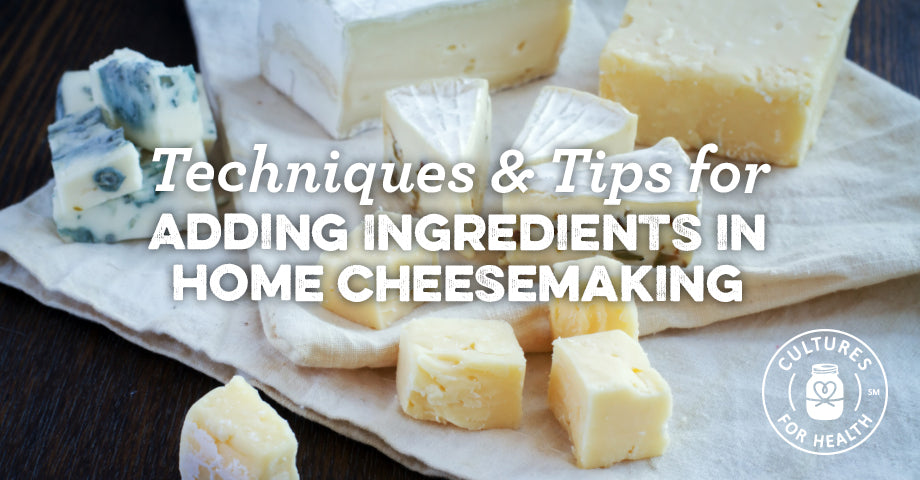
Home cheesemaking requires learning a few new techniques in the kitchen, even if you are an experienced cook. Some ingredients called for in cheese recipes should be added to the milk using specific methods and at specific points in the process. Learn the simple techniques for adding common cheesemaking ingredients and get started making delicious cheeses at home!
ADDING CHEESE CULTURES TO MILK
How to Add Powdered Direct-Set Cultures
- Sprinkle cheese cultures over the surface of the milk.
- Cover and let the cultures rehydrate on the surface of the milk for around 5 minutes.
- Use a perforated spoon or a large whisk to stir them in gently until fully incorporated, 1 to 2 minutes, or as long as the recipe specifies.
- Once cultures are mixed in, cover the pot and leave undisturbed for ripening. Any agitation during this period slows down acidification, which may damage the cheese.
How to Add Prepared Cheese Starters
Add prepared starters using the same method as for dry starter cultures, excluding the rehydration step.
ADDING RENNET AND OTHER COAGULANTS TO MILK
How to Prepare Rennet
Rennet should always be diluted in unchlorinated water. Undiluted rennet will not distribute properly in the milk and may affect curd-setting and/or produce a bad curd. Rennet should be diluted in 20-50 times its own volume of cool, unchlorinated water, or as directed in the recipe.
Rennet, or any coagulant, must be measured carefully.
- Too much rennet will cause the curd to be too firm and rubber-like
- Too little rennet may cause the milk to not separate properly.
When to Add Rennet
Add rennet to milk after the culture has ripened in the milk. After renneting, the milk is left to set: curds coagulate and separate from the whey.
How to Add Rennet
To add rennet to milk, follow the steps below:
- Pour the diluted mixture through a perforated spoon into the milk to help distribute it evenly.
- Use the spoon to begin stirring the milk slowly in an up-and-down motion. Make sure to stir right down to the bottom of the pot. Stir in this way for about a minute, to disperse rennet evenly, or as directed by the recipe.
-
Cover the pot and leave undisturbed for the rest of the coagulation period, to avoid damaging the developing curd and causing loss of butterfat.
ADDING CHEESE COLORING TO MILK
How to Prepare Cheese Coloring
Dilute with unchlorinated water only. If a recipe does not specify the dilution ratio, use 1 part coloring to 20 parts water.
When to Add Cheese Coloring
Add cheese coloring to milk before the ripening period and before the rennet, because it can damage the coagulation properties of the rennet if added later.
How to Add Cheese Coloring
To add cheese coloring to milk, follow the steps below:
- Add coloring by pouring the diluted coloring agent through a perforated spoon into the milk.
- Stir in completely for a minimum of 30 seconds.
Milk will not take on a deep color immediately, because of the high water content within the milk, but as curds are drained and pressed, the color should develop nicely.
ADDING CALCIUM CHLORIDE TO MILK
How to Prepare Calcium Chloride
Dilute calcium chloride as directed by your recipe. The most common ratio is ¼ teaspoon calcium chloride per gallon of milk.
When to Add Calcium Chloride
Add calcium chloride as milk is heated.
How to Add Calcium Chloride
To add calcium chloride to milk, follow the steps below:
- Pour diluted calcium chloride through a perforated spoon into the milk.
- Stir for a minimum of 30 seconds.
When using calcium chloride in a recipe that includes rennet, after adding the rennet, allow the milk to set for an extra 4 to 5 minutes longer than directed by the recipe.
ADDING LIPASE POWDER TO MILK
How to Prepare Lipase Powder
Dilute lipase powder as directed by your recipe. To allow it to rehydrate properly, allow the dissolved lipase sit in the water for about 20 minutes before incorporating it into the milk.
When to Add Lipase Powder
Add lipase powder as directed by your recipe.
How to Add Lipase Powder
Add lipase powder as directed by your recipe.
ADDING MOLD SPORES
Add mold spores as directed by the recipe. Here is a short list of a few popular molds:
- Geotichum Candidum comes as a powder and is added to the milk together with the white mold powder called Penicillium camemberti, in a ratio of 1 part Geotrichum to 5 parts Penicillium. Add to the milk along with the cultures.
- Penicillium Roqueforti is a mold that is rehydrated and incorporated into the milk along with the cultures, or you can also sprinkle it across the surface of the cheese during the molding process.














